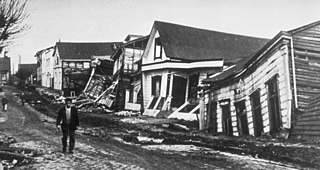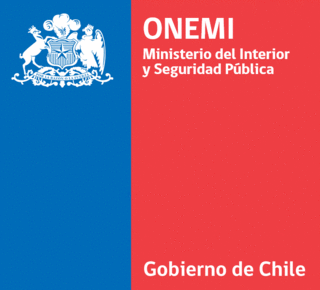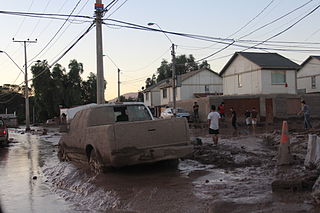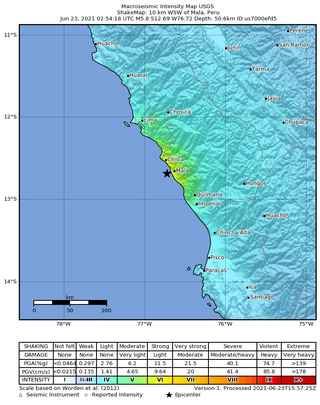
The 1960 Valdivia earthquake and tsunami or the Great Chilean earthquake occurred on 22 May 1960. Most studies have placed it at 9.4–9.6 on the moment magnitude scale, while some studies have placed the magnitude lower than 9.4. This makes it the most powerful earthquake ever recorded. It occurred in the afternoon, and lasted 10 minutes. The resulting tsunamis affected southern Chile, Hawaii, Japan, the Philippines, eastern New Zealand, southeast Australia, and the Aleutian Islands.
The 1922 Vallenar earthquake occurred with a moment magnitude of 8.3 and a tsunami magnitude of 8.7 in the Atacama Region of Chile, near the border with Argentina on 11 November at 04:32 UTC. It triggered a destructive tsunami that caused significant damage to the coast of Chile and was observed as far away as Australia.

ONEMI or National Office of Emergency of the Interior Ministry was a Chilean government agency dedicated to the prevention, organization, coordination and information relative to natural disasters. After the 1960 Valdivia earthquake a committee was formed to solve problems caused by the earthquake. However, this committee was not dissolved afterwards and in 1974, it acquired by law independent status as governmental office.

The 1997 Punitaqui earthquake occurred at 01:03 UTC on October 15. It had an estimated magnitude of 7.1 . This earthquake was one of the most destructive in the epicentral area compared to other events of subduction of the same size. The extensive damage to structures was the result of an amplification effect on the ground and the poor quality of building materials, this reflects the potential for damage incurred in an intraplate earthquake with vertical fault and how it can be much greater than what which can cause one of interplate of similar magnitude, and caused severe damage in Chilean cities of La Serena, Vicuña, Ovalle, Illapel and Punitaqui.

The 2010 Pichilemu earthquakes, also known as the Libertador O'Higgins earthquakes, were a pair of intraplate earthquakes measuring 6.9 and 7.0 that struck Chile's O'Higgins Region on 11 March 2010 about 16 minutes apart. The earthquakes were centred 15 kilometres (9.3 mi) northwest of the city of Pichilemu.

The Concertación de Partidos por la Democracia primaries for the 2012 Chilean municipal elections took place nationally on 1 April 2012. 313,000 people voted in the Concertación primaries in 142 different communes. 142 out of 335 candidates were elected to represent the political conglomerate.

The 2015 Northern Chile floods were a series of mudflows that affected much of northern Chile, product of flash floods from different rivers due to unseasonal heavy rains in the area, causing severe damage in several towns of the Antofagasta, Atacama and Coquimbo regions. Flooding in Chile and Peru resulted from an unusual cold front which moved across the Andes, bringing heavy rainfall to the region.

The 2015 Illapel earthquake occurred 46 km (29 mi) offshore from Illapel on September 16 at 19:54:32 Chile Standard Time (22:54:32 UTC), with a moment magnitude of 8.3–8.4. The initial quake lasted between three and five minutes; it was followed by several aftershocks greater than magnitude six and two that exceeded 7.0 moment magnitude. The Chilean government reported 15 deaths, 6 missing and thousands of people affected. In Buenos Aires, Argentina, a man died from a stroke while he was evacuating a building.

The Valparaíso earthquake of April 2017 was a strong earthquake that shook the cities of Valparaíso and Santiago on Monday, April 24, 2017, at 18:38 local time. Its epicenter was located off the coast of the Valparaíso Region and had a magnitude of 6.9 Mw. On the scale of Mercalli, the earthquake reached an intensity of VII.
The 2019 Copa Chile, was the 40th edition of the Copa Chile, the country's national football cup tournament. Palestino were the defending champions, but were knocked out of the competition by Santiago Morning in the second round. Colo-Colo were the champions, defeating Universidad de Chile 2–1 in the final.

The 2021 Mala earthquake, with a Richter magnitude of 6.0 and moment magnitude of 5.9, struck on June 22, 2021, at 21:54:18 local time (UTC−5) with an epicenter off the coast of Mala in the department of Lima. Following the main event, there were more than 15 aftershocks, with the largest being a magnitude 4.8 event at 07:03 local time on June 23.

A major earthquake struck northern Peru on November 28, 2021, 5:52 a.m. local time with a magnitude of 7.5 on the moment magnitude scale between the Amazonas and Loreto departments of Peru. A maximum Modified Mercalli intensity (MMI) of VII was reported in the town of Santa Maria de Nieva according to the Geological Institute of Peru.
The 2022 Club Deportivo Universidad Católica season is the 82nd season and the club's 48th consecutive season in the top flight of Chilean football. In addition to the domestic league, Universidad Católica are participating in this season's editions of the Copa Chile, the Supercopa de Chile, and the Copa Libertadores.
The 2020 Club Deportivo Universidad Católica season was the 80th season and the club's 46th consecutive season in the top flight of Chilean football. In addition to the domestic league, Universidad Católica participated in the season's editions of the Supercopa de Chile, the Copa Libertadores and the Copa Sudamericana
The 2019 Club Deportivo Universidad Católica season was the 79th season and the club's 45th consecutive season in the top flight of Chilean football. In addition to the domestic league, Universidad Católica participated in the season's editions of the Copa Chile, the Supercopa de Chile, the Copa Libertadores and the Copa Sudamericana
The 2022 Copa Chile, was the 42nd edition of the Copa Chile, the country's national football cup tournament. The tournament began on 19 March 2022 and ended on 13 November 2022, with the final match on neutral ground.
The 2012 Constitución earthquake was recorded on March 25, 2012, at 7:37 pm local time. It had a moment magnitude of 7.1 and its epicenter was located 23 km (14 mi) northeast of the city of Constitución, in the Maule Region, Chile. According to experts, it was a strong and late aftershock of the Great Chile earthquake of February 27, 2010.












